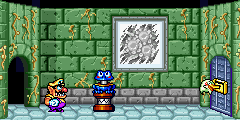Keyzer
Template:Character-infobox Template:Quote2
Keyzer[1], sometimes referred to as a Ghost Key[2], is a small levitating creature which bears some resemblance to a Boo, although with a key for a nose. They are seen in the Game Boy Advance game Wario Land 4, where one must be located by Wario in each of the eighteen stages. A Keyzer will always be found sleeping. Once found, it will wake up and follow Wario until he either loses all his health points, or exits the level via the Vortex. The Keyzer will then unlock the sealed door that leads to the next stage, and will disappear once it does so. Once the door is unlocked, the Keyzer cannot be found within that same stage a second time.
If Wario exits a stage without finding the Keyzer, his points and any jewel pieces collected will still be counted, he just will not be able to progress to the next stage. Wario is able to re-enter any stage where the Keyzer has not been found.
In the Crescent Moon Village stage, a ghost enemy shows an interest in Keyzer, and excitedly tries to steal him from Wario. The ghost's movement will become faster after stealing the Keyzer, which may make it difficult for Wario catch him. Wario simply has to touch the ghost to retrieve the Keyzer, although the ghost will continue trying to steal it.
Keyzer also appears in volume 28 of the Japanese manga series "Super Mario-Kun", on the page showing the chapter's end.
Gallery
- WL4-Keyzer Artwork.png
Alternate artwork of a Keyzer
Keyzer, as seen in a chapter end of Super Mario-Kun
Names in other languages
| Language | Name | Meaning | Notes |
|---|---|---|---|
| Japanese | カギのはし[3] Kaginohashi |
A portmanteau of the Japanese word kagi, meaning "key", and kamonohashi, meaning "platypus". | |
| Chinese | 钥匙怪[9] Yàoshi Guài |
Key Ghost | |
| French | Keyser[6] | - | |
| German | Keyzer[7] | - | |
| Italian | Pellichiave[8] | From pellicano (pelican) and chiave (key) | |
| Spanish | Dormillave[4][5] Pájaro Llave[5] |
From dormir (sleep) and llave (key) Key Bird |
References
- ^ Wario Land 4 European instruction booklet, page 23.
- ^ Nintendo Power Advance V.3, page 53.
- ^ Wario Land Advance: Yōki no Otakara Japanese instruction booklet, page 33.
- ^ Wario Land 4 European instruction booklet, page 103.
- ^ a b Official Wario Land 4 website (Guías Nintendo)
- ^ Wario Land 4 European instruction booklet, page 63.
- ^ Wario Land 4 European instruction booklet, page 43.
- ^ Wario Land 4 European instruction booklet, page 123.
- ^ iQue. 瓦力欧寻宝记. Retrieved February 2, 2017.




